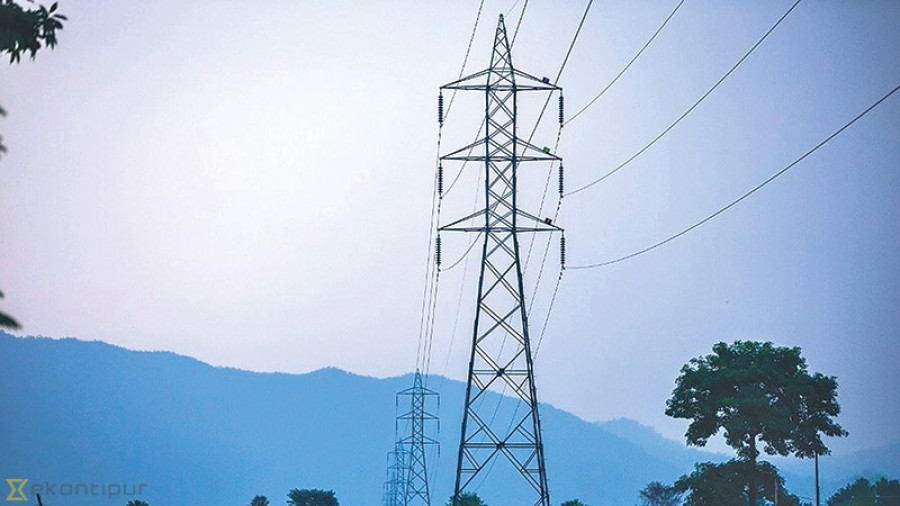Money
Land compensation and right-of-way issues delay power line projects
Experts say there has to be coherence between the social, technical, financial and political factors surrounding transmission line projects.
Prahlad Rijal
The state-owned power utility received a construction licence to build the 132 kV Middle Marshyangdi transmission line in 2002, but it could bring the power infrastructure into operation only in 2019.
After 12 years of struggle, the Kabeli corridor transmission project, touted as the backbone of eastern Nepal's power grid, finally assumed full shape in August.
The under-construction 132 kV Thankot-Chapagaun-Bhaktapur transmission line, intended to strengthen the Kathmandu Valley's power supply system by eliminating voltage fluctuations and ensuring proper load management, has been a work in progress since 2004.
The Middle Marshyangdi, Kabeli and Thankot-Chapagaun-Bhaktapur transmission lines are only three projects in the long list of transmission projects held up by disagreements over land compensation and right-of-way, among others.
And while these projects suffer from what has been often termed ‘obstruction’ from locals, Nepal is losing 4.35 percent of the available energy annually for lack of high-capacity transmission infrastructure.
Apart from transmission loss, delays in building the infrastructure has also led to cost overruns to the tune of millions of rupees.
According to the Nepal Electricity Authority, construction of transmission projects such as the Kali Gandaki, Marshyangdi corridor, Kohalpur-Mahendranagar and Hetauda-Inaruwa schemes is imperative to expand and improve the grid for efficient evacuation of electricity from hydropower plants to the national power system and to ensure increased power supply and reduction of such losses.
These transmission lines are of strategic importance as they help in evacuating energy generated by key hydropower projects to major load centres.
However, the construction of such lines has been halted in many areas across seven provinces with the power utility complaining time and again that land acquisition and right-of-way clearance is taking more time than expected, which has made it difficult to execute such crucial projects on schedule.
Right-of-way refers to the strip of land over which a transmission line passes. Project developers have to pay 10 percent of the market value of the land to acquire right-of-way clearance, and 100 percent of the market value to acquire the land where pylons have to be set up.
As per the current setup, the power utility and other developers have to secure right of way over land 9 metres in width on either side from the power cables in case of 132 kV lines, 15 metres on either side in case of 220 kV lines and 23 metres for building 400 kV lines.
Landowners often complain that once a power line is built, no other infrastructure can be built on the land, trees cannot be planted on the particular strip, and banks do not accept such land as collateral.
For this reason, a majority of owners of land above which electricity cables will pass have demanded that the compensation amount be raised to 50-90 percent of the land value. And some have even demanded the complete transfer of land ownership and compensation of 100 percent of the land value.
Government officials admit that right-of-way issues have arisen out of lack of clear policies on compensation and modality for building power lines without displacing people, degrading private land values or disrupting the social fabric.
“Although it is near impossible to pay 100 percent of the land value to acquire easement rights, in some areas, the concern of communities is genuine and needs to be addressed through clear provisions on compensation,” said Kulman Ghising, managing director of the Nepal Electricity Authority.
“The power utility has been paying up to 25 percent to secure easement rights in highly affected settlements, but the presence of interest groups who deliberately pose obstructions has also hindered grid expansion plans in such areas,” said Ghising.
To limit the negative externalities caused by power lines passing through high-value land near human settlements, the power utility has also recently suggested to the government to incorporate provisions in the Land Acquisition Act requiring banks to accept such land as collateral for loans.
Energy Ministry officials say issues related to compensation and obstruction has mainly arisen in regions where the government has no alternative to pull high-tension cables near human settlements and areas with the possibility of town expansion.
“We are bound to undertake the projects in such areas, and the concern of people in the region is also genuine,” said Prabin Raj Aryal, spokesperson for the Ministry of Energy, Water Resources and Irrigation. “The government is studying viable ways to bring locals onto the same page, and the planning commission is undertaking a study about this matter.”
According to Aryal, while the ministry is deliberating ways to resolve the problem, talks have surfaced on allocating shares to locals in the transmission projects through the government’s People’s Hydroelectricity Programme.
Talk about resolving the issues surrounding transmission projects is not new.
In 2017, the ministry had formed a taskforce to pinpoint suitable ways to acquire right-of-way from private landowners. Two years on, the taskforce has failed to come up with a modality under which landowners would agree to relinquish their property.
Experts say that the land acquisition problem and strong opposition from locals will not come to an end unless there is coherence between the social, technical, financial and political factors surrounding transmission line projects.
“Issues in building transmission lines must be viewed sensitively and addressed on a case-by-case basis instead of applying a blanket policy which would result in discrimination and differential treatment to private landowners,” said Suman Prasad Sharma, a former secretary of the Energy Ministry and an environmental engineer.
“Just because the transmission lines will strengthen the grid and reduce the cost of transferring power does not mean authorities can destroy the livelihood of people who depend solely on their land.”
According to Sharma, apart from poor compensation rates and lack of policy level clarity, many projects have floundered because of deliberate obstruction from political and interest groups, and to address this, the government must take a stern administrative stance while donors must not be obsessed with imposing near impractical guidelines on environmental or social impact without realising the ground reality.
Owing to delays in upgrading the existing high capacity transmission lines and constructing new ones, Nepal’s power system has only been charged to relay 220 kV voltage level while the power utility has long planned to upgrade the capacity to 400 kV level to synchronise Nepal’s grid with India’s for smooth energy exchange between the two countries.
“Nonetheless, we have successfully completed the construction and brought into operation 606 circuit kilometres of transmission lines and added 738 MVA capacity at grid substations this fiscal year,” said Ghising.




 9.12°C Kathmandu
9.12°C Kathmandu













